
A Bibliometric Analysis of Publications in the Web of Science Category of Educational Psychology in the Last Two Decades
[Análisis bibliográfico de publicaciones en la categorĂa de psicologĂa educativa de Web of Science en los dos Ăşltimos decenios]
Daniel Hernández-Torrano1 and Yuh-Shan Ho2
1Nazarbayev University, Graduate School of Education, Kazakhstan; 2Trend Research Centre, Asia University, Taiwan
https://doi.org/10.5093/psed2021a19
Received 20 April 2020, Accepted 18 January 2021
Abstract
Educational psychology is a discipline with a relatively long and intricate history. This study contributes to the understanding of the most recent developments of educational psychology research through the exploration of 35,210 articles published in all journals indexed in the Web of Science educational psychology category for the 2000-2019 period. The results of the study show that the volume of research on educational psychology has doubled during this period and a few journals accumulate most of the research produced in the discipline. Most studies have been published in the English language and in the United States, although research produced in China has experienced the greatest growth. Recent research on educational psychology has predominantly addressed 16 research themes over the last 20 years, although research on child-age students, teaching and teacher education, learning and education, assessment and testing, socio-cultural diversity, learning environments, and educational measurement have captured the greatest attention.
Resumen
La Psicología educativa es una disciplina con una historia relativamente larga e intrincada. Este estudio ayuda a conocer los desarrollos más recientes de la investigación en psicología educativa a través de la exploración de 35,210 artículos publicados en todas las revistas indexadas en la categoría de psicología educativa de Web of Science durante el período 2000-2019. Los resultados del estudio muestran que el volumen de investigación en psicología educativa se ha duplicado durante este período y unas cuantas revistas acumulan la mayor parte de la investigación producida en esta disciplina. La mayoría de los estudios se han publicado en inglés en Estados Unidos, aunque la investigación desarrollada en China ha experimentado el mayor crecimiento. Investigaciones recientes en psicología educativa abordan sobre todo 16 temas de investigación en los últimos 20 años, aunque la investigación en estudiantes en edad infantil, en enseñanza y educación del profesorado, aprendizaje y educación, evaluación y pruebas, diversidad sociocultural, entornos de aprendizaje y medición educativa han captado la mayor atención.
Palabras clave
PsicologĂa educativa, RevisiĂłn, BibliomĂ©trica, Web of Science Core Collection, SSCIKeywords
Educational psychology, Review, Bibliometric, Web of Science Core Collection, SSCICite this article as: Hernández-Torrano, D. and Ho, Y. (2021). A Bibliometric Analysis of Publications in the Web of Science Category of Educational Psychology in the Last Two Decades. PsicologĂa Educativa, 27(2), 101 - 113. https://doi.org/10.5093/psed2021a19
ysho@asia.edu.tw Correspondencia: ysho@asia.edu.tw (Yuh-Shan Ho)Educational psychology is a discipline with a relatively long and intricate history (Alexander et al., 2012; Berliner, 2006; Zimmerman & Schunk, 2003). There is widespread agreement that modern educational psychology begins with the birth of psychology at the hands of Williams James in the late 19th century and the work of G. Stanley Hall, J. Dewey, and especially Edward L. Thorndike, who wrote what is considered the first text in educational psychology. However, it is not until 1920 when educational psychology is commonly recognized as a separate branch of psychology (Glover & Ronning, 1987). Over the last 100 years, educational psychology has evolved to become a distinctive and mature discipline (Glover & Ronning, 1987; Miller & Reynolds, 2003). Keathley-Herring et al. (2016) define the maturity of a field or discipline based on “how and to what extent that area has developed over time, with a special interest in the creation, growth, and dissemination of knowledge” (p. 939). According to the authors, the maturity of a field is determined by a wide variety of criteria, including publication characteristics (publication quantity), research design characteristics (the rigor of methods), theoretical characteristics (development of new theories and applicability of theories), content characteristics (variety of themes, connections between sub-themes), impact (author prominence), diffusion (the existence of communities of practice and professional associations), and academic and research infrastructure (academic programs). The maturity of educational psychology as a discipline in terms of dissemination and infrastructure is evident with the existence of numerous professional organizations such as the Association of Educational Psychologists (AEP) in the United Kingdom, the Division 15 of the American Psychology Association in the United States, and the Canadian Association of Educational Psychology (CAEP) (Reynolds & Miller, 2012); the availability of undergraduate and postgraduate programs in educational psychology in many countries of the world (Kim et al., 2018); and the variety of academic conferences held every year. Other indicators of the maturity of the discipline include great volume and diversity of specialized journals (Hulac et al., 2016) and the wide array of educational psychology topics addressed in the literature, including cognition, behavioral learning, curriculum, individual differences and special populations, and educational measurement, statistics, testing, and instruction, with more recent publications emphasizing motivation and affective development, relational processes, socio-cultural contexts for learning and development, and technology (Craighead & Nemeroff, 2000; McInerney, 2005; Pressley & Roehrig, 2003; Reynolds & Miller, 2012). Despite its progressive maturation, educational psychology has suffered from an identity crisis since its inception and has long been characterized as a fragmented discipline. Scholars have perennially debated about its nature and unique features and tried to clarify the intimate ties but unclear boundaries with respect to related disciplines such as school psychology and counselling psychology (Glover & Ronning, 1987). This is further complicated by its interdisciplinary nature (Alexander, 2018; Craighead & Nemeroff, 2000; Harris, 2018), its broadening scope and constant evolution (McInerney, 2005; Pressley & Roehrig, 2003; Zimmerman & Schunk, 2003), and the divergence of theoretical, methodological, and contextual perspectives that underpin the discipline (Bredo, 2016; Miller & Reynolds, 2003; Penuel & Frank, 2016). To address some of these issues, scholars have, for some time, attempted to synthesize the research and narrative literature on educational psychology to offer researchers, practitioners, policymakers, and the general public insights to support the effective development and application of psychological principles to educational practice. Such syntheses are important because they envision past, present, and future developments of a discipline. In this context, bibliometrics has been proposed as a valuable approach to map vast amounts of research available disciplines and to describe their developmental trends and status in a comprehensive, systematic, and replicable manner (Linnenluecke et al., 2020). Bibliometrics can be generally defined as “a set of quantitative methods used to measure, track, and analyze print-based scholarly literature” (Roemer & Borchardt, 2015, p. 234). Bibliometrics are typically used to describe and assess journal, country/region, institution, and author rankings in terms of productivity, and to reveal patterns of similarity and collaboration (Andres, 2009). Bibliometric approaches have been progressively incorporated into the social sciences to map disciplines, fields, and selected topics (Ivanovi & Ho, 2019; Wang & Ho, 2019). Bibliometric reviews of research in global psychology are available exploring both the general literature (Krampen 2016; Krampen et al. 2011; Ho & Hartley, 2016) and specialized journals in the discipline (Jennings et al., 2008; Milfont & Page, 2013; Mintegi et al., 2011; Reutzel & Mohr, 2015; Tur-Porcar et al., 2018). Similar procedures have been implemented to map psychological research in particular geographical regions such as Asia (Haslam & Kashima, 2010), Europe (Íñiguez-Rueda et al., 2008; Schui & Krampen, 2007), South America (Fierro et al., 2018), and the post-Soviet countries (Fedorov, 2019; Lovakov & Agadullina, 2019). Researchers have also used bibliometric approaches to map the literature produced in several branches of psychology, such as positive psychology (Schui & Krampen 2010), personality psychology (Allik, 2013), and applied psychology (Romeo et al., 2017). Educational psychology is not an exception, and bibliometric studies have also been widely conducted to explore the development and structure of the discipline as well as closely related areas, such as school psychology (Begeny et al., 2018; Begeny et al., 2019; Carper & Williams, 2004; Hulac et al., 2016; Kim et al., 2018; Kranzler et al., 2011; Liu & Oakland, 2016; Price et al., 2011; Wang et al., 2020). Moreover, several bibliometric studies have been published to review selected topics in educational psychology, such as e-learning, (Hung, 2012; Li et al., 2019), creativity (Hernández-Torrano & Ibrayeva, 2020; Long et al., 2014), and bullying (Fuentes Cabrera et al., 2019), among many others. The review of these articles is outside of the scope of this study. The present study aims to further contribute to the understanding of the most recent development and structure of educational psychology research using a descriptive bibliometric approach. More specifically, this study provides an account of the evolution of educational psychology research over the last 20 years describing trends in publication language, volume and distribution of publications and citations, productivity and impact of core journals, predominance and collaboration patterns of countries and institutions in the field, and major research themes addressed in the field over the last two decades. With the help of this approach, the trends of scientific research in educational psychology and the hotspots in the discipline in the last 20 years can be identified and summarized. The data-driven approach used in this study synthesizes the most recent developments in educational psychology research and provides a comprehensive picture of the evolution of the scholarly interest in the discipline. The findings have the potential to inform future studies by identifying strengths and gaps in educational psychology research in terms of its growth patterns, impact, and coverage. As in most of the previous bibliometric mappings of the educational psychology literature, the present study focuses on recent developments of the discipline (in our case, the period 2000-2019), and relies on research publications indexed in the Web of Science database, which is the most frequently used database for bibliometric research and is considered the “industry standard” in most disciplines (Ivanovi & Ho, 2019). However, our approach differs from and complements previous studies in several important ways. First, we adopt an integrative approach and use the term educational psychology to encompass all research that has to do with the psychological and educational processes and outcomes associated with the teaching and learning of students in all stages of development, in contrast to previous studies that have examined related disciplines such as school psychology (Hulac et al., 2016; Liu & Oakland, 2016; Price et al., 2011) and selected topics (Fuentes Cabrera et al., 2019; Hernández-Torrano & Ibrayeva, 2020; Li et al., 2019). Second, previous studies have described the evolution of research on educational psychology by examining publications in a restricted number of specialized journals (Begeny et al., 2018; Begeny et al., 2019; Wang et al., 2020), targeting particular researchers or programs in the field (Hulac et al., 2016; Kranzler et al., 2011), or using keywords to identify relevant articles (Liu & Oakland, 2016). Our review provides a wider coverage of the extant literature, both in terms of volume and geographical representation, by examining all the articles published in journals indexed in the Social Science Citation Index (SSCI) Web of Science’s category of educational psychology. Finally, we aim to identify the research themes that have captured the greatest attention in the field and their evolution over time (Mao et al., 2010), an issue that has not been comprehensively addressed in previous bibliometric reviews (Carper & Williams, 2004; Kranzler et al., 2011; Price et al., 2011). Search Strategy Data relevant to the present study were derived from the Social Science Citation Index (SSCI) Web of Science Core Collection by Clarivate Analytics. The SSCI indexes a total of 3,485 journals across 58 Web of Science categories, and 60 of them are listed in the category of educational psychology in 2019 (Clarivate Analytics, 2020). All documents in the SSCI educational psychology category from 2000 to 2019 were retrieved (N = 43,374 documents) (updated on July 23, 2020). The search was filtered by type of document, and only journal articles were extracted because other document types do not contain complete descriptions of the research and the results (Ho et al. 2010). No other filters were applied when selecting the documents for analysis (e.g., publication language). This yielded a total of 35,210 articles, which were retained and analyzed in the present study (see Figure 1). Metadata from these articles was downloaded into a spreadsheet, manually coded, and analyzed using Microsoft Excel 2016 basic functions such as “Filter”, “Pivot Table Wizard”, Convert Text to Columns Wizard, and “Insert” function: “CONCATENATE”, “RANK”, “COUNTA”, “VLOOKUP”, “PROPER”, and “LOWER” following Li and Ho (2008) and Ho and Fu (2016). In this study, we use the corresponding author term instead of the reprint author term used in the SSCI database (Ho, 2012). Where authorship is unspecified in a single-author article, the single author was coded as both first and corresponding author. Similarly, in a single-institution article, the institution is classified as first and corresponding-author institution (Ho, 2014). In a single-author article where authorship is unspecified, the single-author is coded as both first and corresponding author. When a publication included multiple corresponding authors, only the last corresponding author, institution, and country were considered in the analysis (Ho, 2019). In multi first-author publications, only first-author, affiliation, and country were considered. All publications authored by researchers and institutions from England, Wales, Scotland, and Northern Ireland were grouped as originating from the United Kingdom (Chiu and Ho, 2005), and those published in Hong Kong before 1997 were merged with the articles generated in China (Fu et al., 2012). Data Analysis Trends on publication language, field productivity, and publication journals were examined using multiple bibliometric indicators. For publication language, total number of publications (TP) in terms of frequency count and percentage of articles in the dataset published in each language was reported. Publication trends were described accounting for total number of publications (TP), number of authors (AU), number of authors per publication (APP), number of references cited (NR), number of references cited per publication (NRP), total page count (PG), total page count per publication (PGP), number of journals in Web of Science category of educational psychology (NJ), and number of journals in Web of Science category of educational psychology per publication (NJP). Journal productivity was examined looking at the total number of publications (TP) published in each journal indexed in the Web of Science educational psychology category, number of authors per article (APP), and journal impact factor in 2019 (IF2019) (Ho & Fu, 2016; Li & Ho, 2008). Publication performance of countries and institutions on educational psychology research was analyzed using six bibliometric indicators: (1) total number of publications (TP), which reflects the total number of publications produced by a country or an institution in the discipline; (2) independent publications (IP), which accounts for the number of single-country or single-institution publications; (3) collaborative publications (CP), indicating the number of publications produced in collaboration with at least another country or institution; (4) first-author publications (FP), or records where a researcher from a given country or institution appears as first-author; (5) corresponding-author publications (RP), idem as to the previous indicator, but for corresponding-author; and (6) single-author publications (SP), reflecting records published by a single researcher (Chiu & Ho, 2005; Ho & Kahn, 2014; Ho et al., 2010). First authors and corresponding authors are typically considered as those who contributed the most in the development of the publication. At institutional level, the institution of the corresponding author could be considered the home base of the study and, therefore, the intellectual origin of the paper (Ho, 2012). The major research themes addressed in the educational psychology literature and their evolution trends over the last 20 years was analyzed in two steps. First, the most frequently used terms in the articles titles, abstracts, author keywords, and KeyWords Plus were reported for the period 2000-2019 and across four 5-year sub-periods: (1) 2000-2004, (2) 2005-2009, (3) 2010-2014, (4) 2015-2019 (Zhang et al., 2010). Second, a “word cluster analysis” based on the distribution of these terms across publications was used following the procedures implemented by Mao et al. (2010) and Wang and Ho (2016). A word cluster analysis analyzes the distribution of words in article titles, abstracts, author keywords, and KeyWords Plus to evaluate research main focuses or hotspots and their trends in a topic or discipline. It consists of several steps. Initially, similar title words, author keywords, and KeyWord Plus are combined together as “word sources”. Then, researchers use their specialized knowledge to distil “word clusters” that bring together semantically related “word sources.” Thus, each “word cluster” is composed of several synonymic words or congeneric phrases (i.e., supporting words) and represent possible main focuses or hotspots in the discipline. Finally, by analyzing the number of publications containing these “word clusters”, an outline of the research hotspots and their developmental trends can be obtained. Publication Language A total of the 35,210 articles were published in the Web of Science category of educational psychology in SSCI from 2000 through 2019 in seven languages. English was the most popular language and comprises 90% of the total articles. Some other languages that were less used were as follows: Russian (4.3%), German (3.2%), Japanese (1.6%), and Spanish (1.2%). French and Portuguese appeared only in five and three articles, respectively. One article was classified as Japanese and English in the Japanese Journal of Educational Psychology. Two articles were classified as English and Estonian in Child Development. Articles published in English had a higher number of authors per article (M = 3.1) than non-English (M = 2.2). Publication Trends From 2000 through 2019, the annual number of articles, the number of authors per publication, and the number of references cited per publication in the Web of Science category of educational psychology increased slightly (Table 1). The number of articles increased from 1,216 in 2000 and 1,114 in 2001 to 2,577 in 2019, with almost the same in total page count per publication with an average article length of 15 pages from 2000 to 2004 and 16 pages after 2004. Average cited references fluctuated, showing a minimum of 39 in 2000 and a maximum of 59 in 2019, with an overall average cited references of 48. Average number of authors per article also exhibited some variation over the years, from a minimum of 2.4 authors per article in 2000 to a maximum of 3.5 in 2019; overall average was 2.9 authors per article. Table 1 Characteristics of Articles in the Web of Science Category of Educational Psychology (2000–2019)  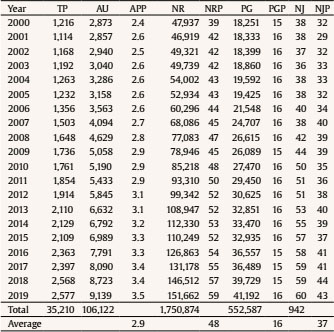 Note. TP = number of articles; AU = number of authors; APP (AU/TP) = number of authors (AU) per publication (TP); NR = number of references cited; NRP = number of references cited per publication (TP); PG = total page count; PGP = total page count per publication (TP); NJ = number of journals in Web of Science Category of educational psychology; NJP = number of journals in Web of Science Category of educational psychology per publication. Journal Top 20 journals in the Web of Science category of educational psychology, along with total number of publications (TP), number of authors per article (APP), as well as their impact factor in 2019 (IF2019) are listed in Table 2. Child Development stood out as core journal in the field publishing the highest number of publications, with 2,661 articles and 7.6% of the records in the dataset, followed by Learning and Individual Differences, Vapors Psikhologii, and Psychology in Schools, all with more than 4% of all journals articles each. The most influential journals in educational psychology (i.e., high impact factor) in 2019 were Educational Psychology Review (IF2019 = 5.167), Journal of Educational Psychology (IF2019 = 5.028), and Child Development (IF2019 = 4.891). Table 2 Twenty Productive Journals in Web of Science Category of Educational Psychology   Note. TP = total number of articles; AU = number of authors; APP (AU/TP) = number of authors (AU) per publication (TP); IF2019 = journal impact factor in 2019. Figure 2 shows the growth trends in the number of publications of the top eight productive journals in 2019. Three interesting trends are observable. First, Child Development appears as the most productive journal in educational psychology for most of the past 20 years. Second, Learning and Individual Differences increased the number of publications significantly, especially from 2010, reaching a peak in 2016 with 250 articles. However, in the last three years, the number of publications in this journal has decreased significantly. Third, the volume of publications in the other six top journals has gradually grown in the last 20 years at a similar pace. Countries Productivity There were 746 articles (2.1% of 35,210 articles) without authors’ affiliations in the SSCI database. The 34,464 articles with author affiliations were generated in a total of 118 countries around the world. Among them, 29,098 (84%) were single country articles from 81 countries, and 5,366 (16%) were internationally collaborative articles from 114 countries. Top 20 productive countries are listed in Table 3, along with six publication indicators (Ho & Kahn, 2014). Twelve European countries, five Asian countries, two American countries, and one Oceania country appear as the most productive countries in educational psychology research. The most productive African country was South Africa with 122 articles and ranking 28th. The USA appeared as the absolute leader in educational psychology research and ranked top in all six publication indicators with TP of 18,747 articles (54% of 34,464 articles), IP of 15,899 articles (55% of 29,098 country independent articles), CP of 2,848 articles (53% of 5,366 internationally collaborative articles), FP of 17,202 articles (50% of 34,464 first-author articles), RP of 17,213 articles (50% of 34,433 corresponding author articles), and SP of 2,617 articles (48% of 5,495 single-author articles). Germany and the United Kingdom follow in the ranking, both with nearly 3,000 publications each. Table 3 The Top 20 Most Productive Countries   Note. TP = total number of articles; TPR (%) = rank of total number of articles and percentage; IPR (%) = rank of single country articles and percentage in all single country articles; CPR (%) = rank of internationally collaborative articles and percentage in all internationally collaborative articles; FPR (%) = rank of first-author articles and percentage in all first-author articles; RPR (%) = rank of corresponding-author articles and percentage in all corresponding-author articles; SPR (%) = rank of single-author articles and percentage in all single-author articles. Positions in the rankings for the rest of the top 20 most productive countries seem to be relatively stable across all publication indicators. In other words, if a country ranks high for one indicator, it will perform similarly high for other indicators. For example, Australia ranks sixth in the total number of publications (TP = 1,514), first-author (FP = 3.2%), corresponding-author articles (RP = 3.2%), and single-author publications (SP = 3.6%), fifth in internationally collaborative articles (CP = 13%), and seventh in single country publications (IP = 2.8%). The only notable inconsistencies in this pattern seem to be the cases of Russia and Japan. These two countries rank 9th and 10th in the number of total publications, respectively, but 28th and 23rd in internationally collaborative articles, suggesting that researchers in these countries tend to form research collaborations predominantly within national borders. Figure 3 shows the growth trends in the number of publications of the top eight productive countries with 100 articles or more in 2019. The results show that, in general, all countries have progressively increased the number of annual publications in educational psychology as we approach the present. The most notable growths are in Germany, which has managed to remain since 2012 as the most productive country in the field, after the United States, and China, whose productivity has grown steadily in the last five years and currently ranks as the fourth most productive country in 2019. Institutions Productivity A total of 15,722 articles (46% of 34,464 articles with information about affiliation) were intra-institutional articles (SP) and 18,742 (54%) were inter-institutionally collaborative articles (CP). Table 4 shows the 20 most productive institutions in educational psychology research over the last 20 years. The University of Maryland in USA ranked top in the five publication indicators with TP of 580 articles (1.7% of 34,464 articles), with IP of 185 articles (1.2% of 15,722 institute independent articles), CP of 429 articles (1.3% of 18,742 inter-institutional collaborative articles), FP of 348 articles (1.0% of 34,464 first-author articles), and RP of 351 articles (1.0% of 34,881 corresponding author articles). The University of Utrecht in the Netherlands published 327 articles (rank 17th) and was the only one not located in the USA. Table 4 The top 20 Most Productive Institutes  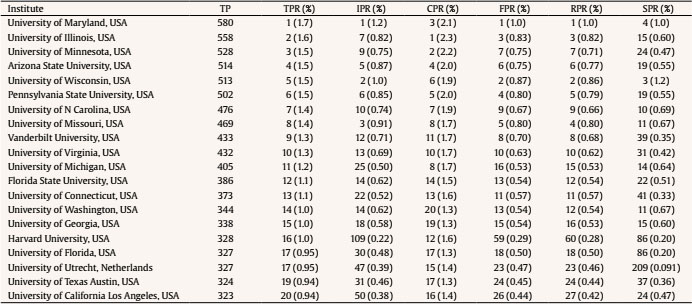 Note. TP = total number of articles; TPR (%) = rank of total number of articles and percentage; SPR (%): rank of single institute articles and percentage in all single institute articles; CPR (%) = rank of inter-institutionally collaborative articles and percentage in all inter-institutionally collaborative articles; FPR (%) = rank of first-author articles and percentage in all first-author articles; RPR (%) = rank of corresponding-author articles and percentage in all corresponding-author articles; SPR (%) = rank of single-author articles and percentage in all single-author articles. As with countries, there is a correlation between the ranking of institutions across all publication indicators – except for single-institute articles ranking, which does not seem to follow the same trends. However, Harvard University stands out as an outlier in the distribution of published articles. While it ranks 16th in terms of the total number of publications in educational psychology, it occupies much lower positions for internationally collaborative (109th), first-authored (59th), and corresponding-authored articles rankings (60th). Also, the University of Utrecht in the Netherlands occupies a noticeably low position in the publication of intra-institution articles, which could partially explain its high position in the total publication ranking. Research Focuses and Their Trends Ho’s group proposed distributions of article titles (Li et al., 2009), abstract (Zhang et al., 2010), author keywords (Xie et al., 2008), and KeyWords Plus (Xie et al., 2008) in different periods to understand focuses in a research topic. Data were separated into 4 five-year periods to analyze the roughly variations of trends (Xie et al., 2008). Article titles. Table 5 shows the 30 most frequently used words in the titles for the period 2000-2019, as well as in four time periods within the timespan. “Children” (12% of 33,210 articles), “students” (11%), and “schools” (10%) were the most frequently used title words in the last two decades. Other frequently used title words included “learning” (8.9%), “reading” (7.1%), and “development” (5.8%), all with more than 2,000 appearances in the dataset. Five words demonstrated a notable increase from 2000-2004 to 2015-2019: “student”, showing a rise of 20 positions in the ranking for this period (↑20 positions), “motivation” (↑21), “teacher” (↑26), “language” (↑27), and “comprehension” (↑54). Three words experienced considerable decreases in their appearance in article titles: “cognitive”, which declined 10 positions in the ranking from 2000-2004 to 2015-2019 (↓10), “behavior” (↓15), and “psychology” (↓51). Article abstracts. The analysis of frequency shows that “students” (30% of 34,671 articles with abstract), “research” (31%), “school” (27%), and “children” (27%) are the most frequently occurring words in the abstracts of the articles published on educational psychology for the timespan considered in this study. No extraordinary changes in rankings are appreciated as we move to the present. Still, a positive increase in usage over time can be observed for “levels”, which moved up 10 positions in the ranking from 2000-2004 to 2015-2019 (↑10 positions), “skills” (↑11), “achievement” (↑13), “positive” (↑15), and “student” (↑25) terms. Conversely, four terms tend to appear less frequently as we approach the present: “group” (↓9), “cognitive” (↓9), “groups” (↓12), and “measures” (↓16). The results of analysis words in article abstracts showed that high frequently used words were general terms. The bibliometric results offered less significant information for finding research focuses. Author keywords. Table 6 presents the frequency count of top 30 author keywords used in the articles included in the dataset. The results indicate that “motivation” is the most frequently used author keyword by authors for the whole period, which appeared in 3.5% of the 21,142 articles with author keywords, followed by “academic achievement” (2.3%), “assessment” (2.1%), “reading” (2.0%), and “reading comprehension” (1.9%). The following author keywords demonstrated a striking increase in appearance over time: “intervention”, which increased 92 positions in the ranking from 2000-2004 to 2015-2019 (↑92 positions), “creativity” (↑114), and “academic performance” (↑141). Other notable increases in the ranking were observed for “bullying” (↑54) and “writing” (↑58) terms. However, “dyslexia” (↓23), “learning” (↓26), and “intelligence” (↓32) were author keywords that showed the most pronounced decreases in ranking positions through time. KeyWords Plus. KeyWords Plus appearing in the articles were calculated and ranked by the total 20-year period and the four sub-periods. The results for the top 30 KeyWords Plus are presented in Table 7. “Children” (13% of 31,555 articles with KeyWords Plus), “students” (11%), “performance” (9.2%), and “achievement” (8.3%) terms occupy top positions in the ranking. Terms that have achieved higher positions in the ranking of most frequently used KeyWords Plus over time include “predictors” (↑22 positions), “intervention” (↑25), “mathematics” (↑31), and “working memory” (↑51). On the other hand, there were three terms that have slightly gone down in the rankings over the last 20 year-period: “instruction” (↓8), “acquisition” (↓11), and “strategies” (↓12). Evolution of main themes. A “word cluster analysis” was employed to analyze the evolution of the main themes in the research literature on educational psychology (Mao et al., 2010; Wang & Ho, 2016). Based on this procedure, we identified 16 research themes addressed in the literature over the last 20 years, organized in five broad research areas: (1) students – student engagement and motivation, reading and language development, individual variations, cognition, and affection and emotion; (2) developmental stages – children, adolescents, and adults; (3) teaching and teacher education, learning and education, assessment and testing, and STEM education; (4) educational contexts – socio-cultural diversity, family contexts, and learning environments; and (5) research and measurement, which was considered a theme on its own. A list of the supporting words for each research theme is provided in the Appendix. Figure 4 shows the publication trends for main research themes identified in educational psychology grouped in the five broad areas: students (Figure 4A), developmental stages (Figure 4B), teaching, learning, and education (Figure 4C), educational contexts (Figure 4D), and research and measurement (Figure 4E). Overall, the findings show that research interest in all the themes has slightly increased from 2010 to 2019, which is probably due to an increase in the number of publications in the discipline in the last 20 years rather than a recent focus on these themes. Moreover, the fact that there are no exponential increases in the growth of any of the themes is reasonable considering that all these topics have been part of the research agenda of educational psychology researchers for quite a long time (Craighead & Nemeroff, 2000; McInerney, 2005; Pressley & Roehrig, 2003; Reynolds & Miller, 2012). Still, a detailed analysis of the trends in each area reveals interesting insights about the most recent developments on research interests in educational psychology over the last two decades. First, the number of publications addressing topics related to students (i.e., cognition, individual variations, affection and emotion, reading and language development, and student engagement and motivation) has grown in parallel, with no particular theme dominating research on this broad area. Second, educational psychology research on children is more prevalent and has grown at a faster speed than research examining learners at other developmental stages (i.e., adolescence and adulthood) over the last 20 years. Third, publications on learning and education, assessment and testing, and teacher and teacher education have grown following similar patterns, although research on the first two topics has received more attention than the later topic through the whole period considered. Educational psychology research on STEM education is scarce and has increased little in the past 20 years. Fourth, in terms of research addressing educational contexts, it is clear that educational psychologists have paid more attention to the influence of learning environments (school and classroom contexts) and socio-cultural contexts (culture, race, and gender) in learning and education compared to the role played by family contexts. Fifth, publications related to research and measurement in educational psychology scholarship have received increased attention over the last 20 years. Thus, in the year 2000 only 360 publications were categorized as falling under this area, and by the year 2019 the number of publications reached 1,477. This bibliometric review provides a comprehensive overview of the development and structure of educational psychology research from 2000 to 2019. Based on our analysis, research on educational psychology has increased slightly in the last 20 years and most of the publications in the discipline are published in the English language. The United States is the absolute leader in educational psychology research and accounts for more than 50% of the total number of publications. The University of Maryland stands out as the most productive institution in the discipline. Four journals account for approximately 20% of the publications in educational psychology: Child Development, Learning and Individual Differences, Voprosy Psikhologii, and Psychology in the Schools. However, the most influential journals in the discipline are Educational Psychology Review, Journal of Educational Psychology, and Child Development. Research trends as shown by the analysis of words in titles, author keywords, and KeyWords Plus elucidated that recent research on educational psychology has predominantly addressed 16 research themes, organized in five broad areas: (1) students – student engagement and motivation, reading and language development, individual variations, cognition, and affection and emotion; (2) developmental stages – children, adolescents, and adults; (3) teaching and teacher education, learning and education, assessment and testing, and STEM education; (4) educational contexts – socio-cultural diversity, family contexts, and learning environments; and (5) research and measurement. Most of these themes were popular at the beginning of the century and had developed at a similar speed, although research on child-age students, teaching and teacher education, learning and education, assessment and testing, socio-cultural diversity, learning environments, and measurement have captured the greatest attention. One of the limitations of this review is that all publications considered are indexed in the Web of Science database. Despite being the most popular dataset for bibliometric research, Web of Science is biased against studies in social sciences and humanities and not published in the English language (Mongeon & Paul-Hus, 2016). Future studies may replicate our results in other multidisciplinary databases (i.e., Scopus) or specialized in psychological research (i.e., PsycInfo). Moreover, other researchers can cover in future reviews relevant research not published in journals indexed under the educational psychology category in the Web of Science database, which was not included in our study. This study offers a review of the most recent developments of educational psychology research, mainly through the analysis of journal articles in educational psychology journals. Other scholars could analyze developmental trends by looking at other documents that also contribute to advancing knowledge of educational psychology, such as book chapters and conference proceedings. Nevertheless, we believe that our study offers a novel and comprehensive picture of recent developments of educational psychology research and provides useful information for researchers to understand the evolution of the discipline. Conflict of Interest The authors of this article declare no conflict of interest. Cite this article as: Hernández-Torrano, D., & Ho, Y. S. (2021). A bibliometric analysis of publications in the web of science category of educational psychology in the last two decades. Psicología Educativa, 27(2), 101-113. https://doi.org/10.5093/psed2021a19 Referencias |
Cite this article as: Hernández-Torrano, D. and Ho, Y. (2021). A Bibliometric Analysis of Publications in the Web of Science Category of Educational Psychology in the Last Two Decades. PsicologĂa Educativa, 27(2), 101 - 113. https://doi.org/10.5093/psed2021a19
ysho@asia.edu.tw Correspondencia: ysho@asia.edu.tw (Yuh-Shan Ho)Copyright © 2025. Colegio Oficial de la Psicología de Madrid




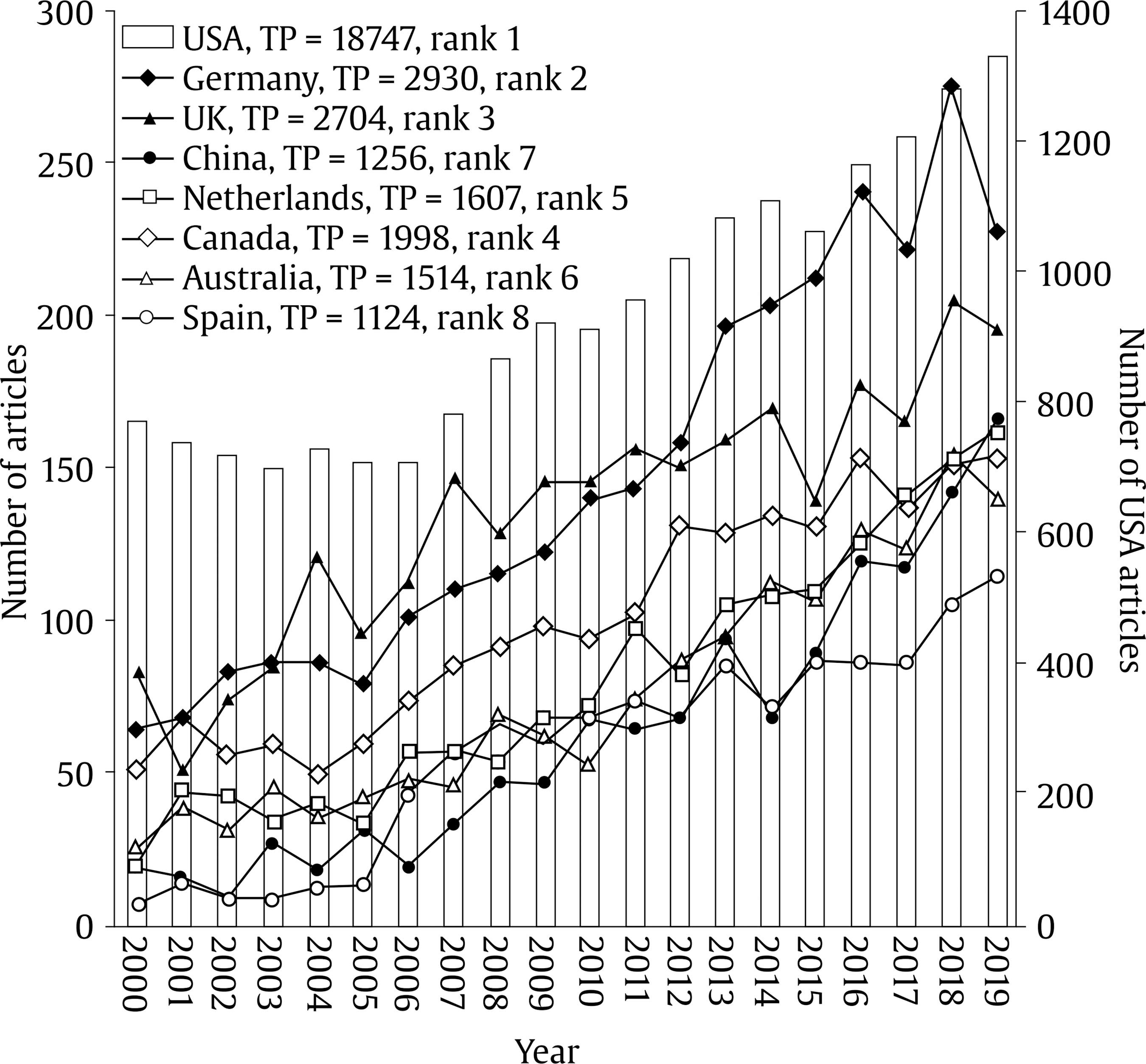
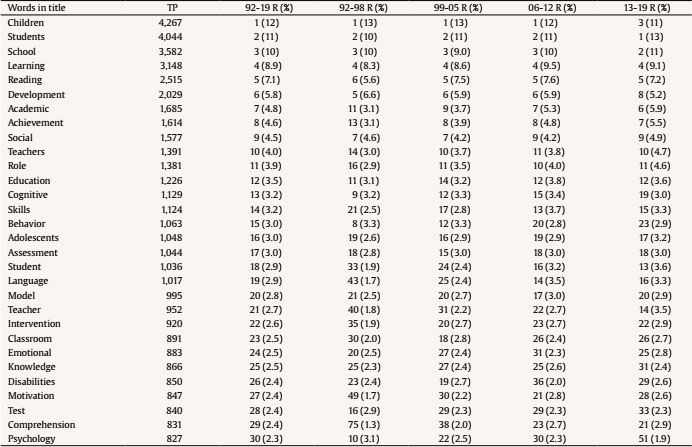
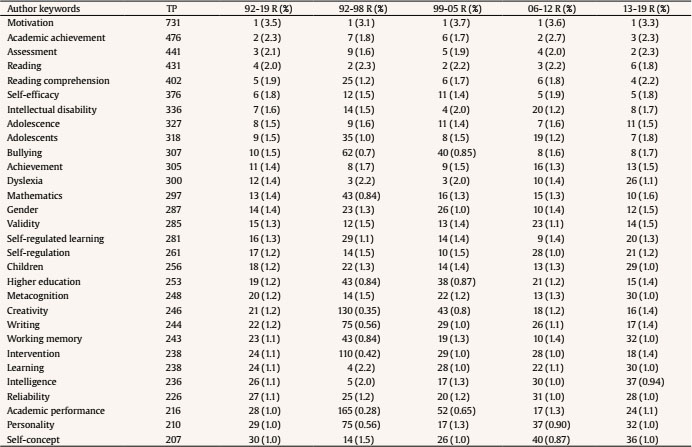
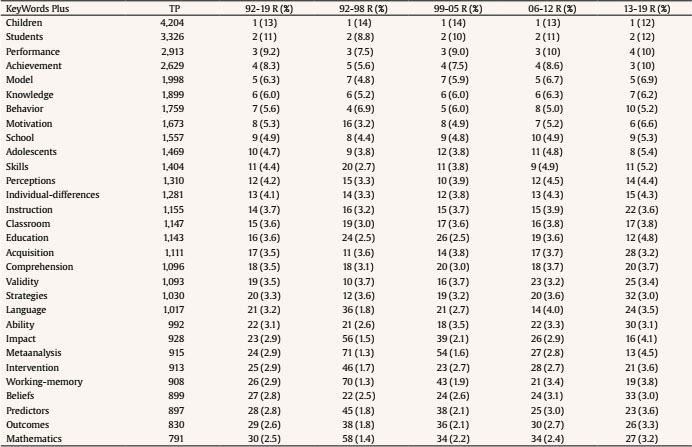
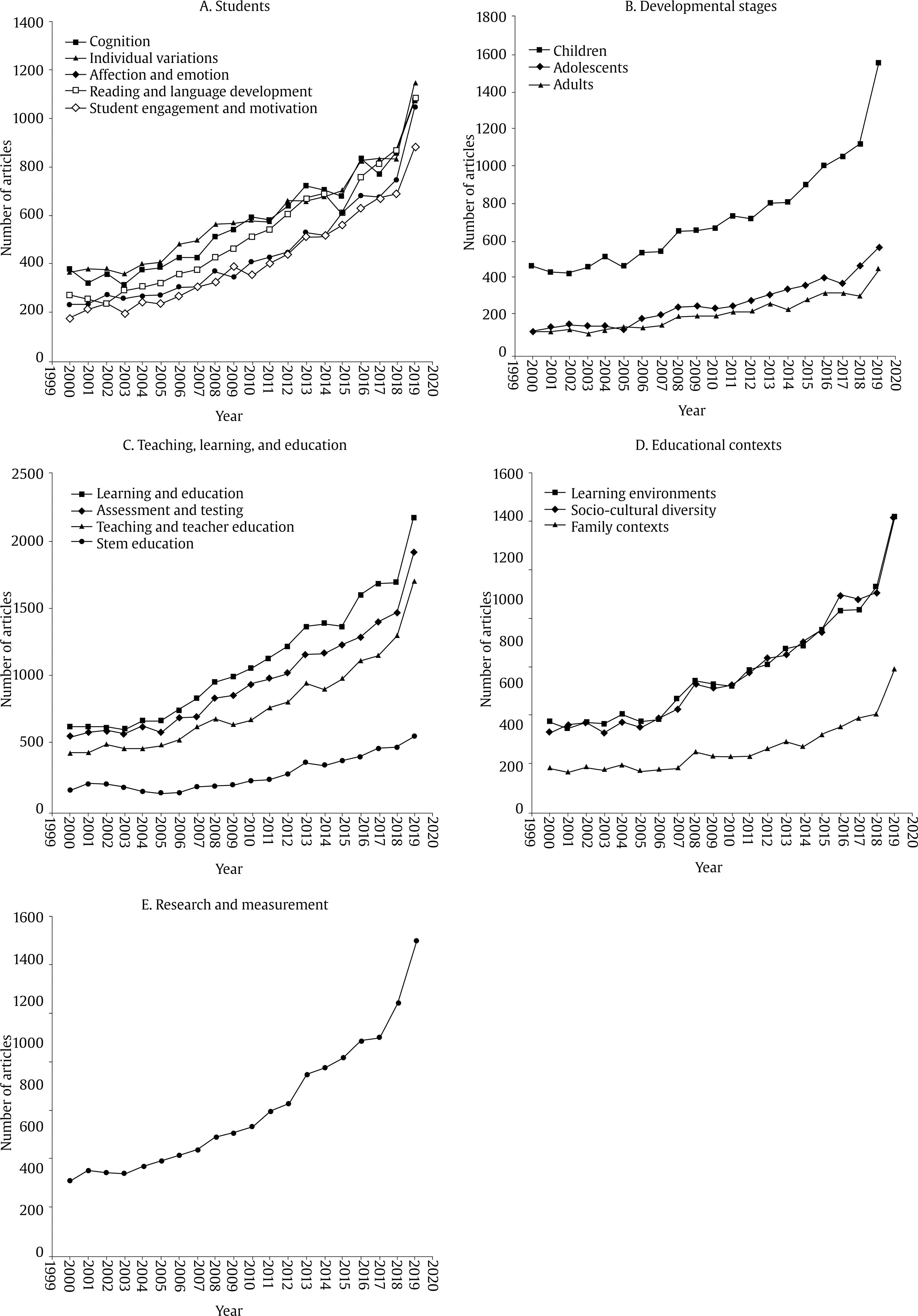







 e-PUB
e-PUB CrossRef
CrossRef JATS
JATS








